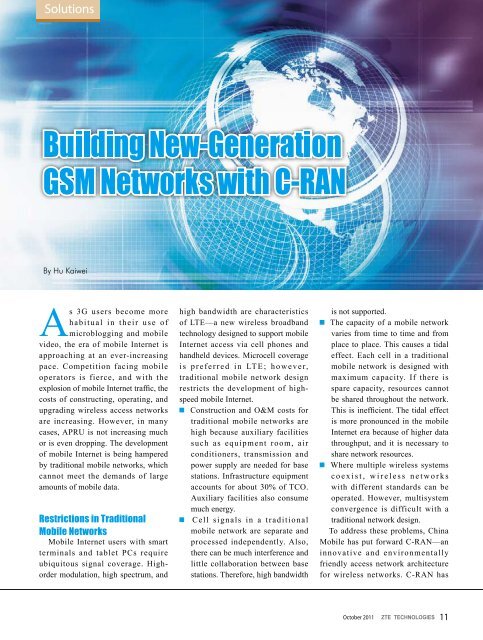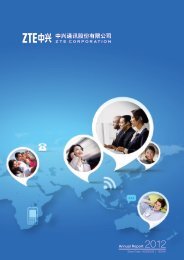PDF download - ZTE
PDF download - ZTE
PDF download - ZTE
You also want an ePaper? Increase the reach of your titles
YUMPU automatically turns print PDFs into web optimized ePapers that Google loves.
Solutions<br />
By Hu Kaiwei<br />
As 3G users become more<br />
habitual in their use of<br />
microblogging and mobile<br />
video, the era of mobile Internet is<br />
approaching at an ever-increasing<br />
pace. Competition facing mobile<br />
operators is fierce, and with the<br />
explosion of mobile Internet traffic, the<br />
costs of constructing, operating, and<br />
upgrading wireless access networks<br />
are increasing. However, in many<br />
cases, APRU is not increasing much<br />
or is even dropping. The development<br />
of mobile Internet is being hampered<br />
by traditional mobile networks, which<br />
cannot meet the demands of large<br />
amounts of mobile data.<br />
Restrictions in Traditional<br />
Mobile Networks<br />
Mobile Internet users with smart<br />
terminals and tablet PCs require<br />
ubiquitous signal coverage. Highorder<br />
modulation, high spectrum, and<br />
high bandwidth are characteristics<br />
of LTE—a new wireless broadband<br />
technology designed to support mobile<br />
Internet access via cell phones and<br />
handheld devices. Microcell coverage<br />
is preferred in LTE; however,<br />
traditional mobile network design<br />
restricts the development of highspeed<br />
mobile Internet.<br />
Construction and O&M costs for<br />
traditional mobile networks are<br />
high because auxiliary facilities<br />
such as equipment room, air<br />
conditioners, transmission and<br />
power supply are needed for base<br />
stations. Infrastructure equipment<br />
accounts for about 30% of TCO.<br />
Auxiliary facilities also consume<br />
much energy.<br />
Cell signals in a traditional<br />
mobile network are separate and<br />
processed independently. Also,<br />
there can be much interference and<br />
little collaboration between base<br />
stations. Therefore, high bandwidth<br />
is not supported.<br />
The capacity of a mobile network<br />
varies from time to time and from<br />
place to place. This causes a tidal<br />
effect. Each cell in a traditional<br />
mobile network is designed with<br />
maximum capacity. If there is<br />
spare capacity, resources cannot<br />
be shared throughout the network.<br />
This is inefficient. The tidal effect<br />
is more pronounced in the mobile<br />
Internet era because of higher data<br />
throughput, and it is necessary to<br />
share network resources.<br />
Where multiple wireless systems<br />
coexist, wireless networks<br />
with different standards can be<br />
operated. However, multisystem<br />
convergence is difficult with a<br />
traditional network design.<br />
To address these problems, China<br />
Mobile has put forward C-RAN—an<br />
innovative and environmentally<br />
friendly access network architecture<br />
for wireless networks. C-RAN has<br />
October 2011<br />
<strong>ZTE</strong> TECHNOLOGIES<br />
11

















